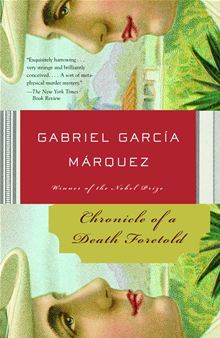- The Good: A rich account of one person’s death that describes much of human nature
- The Bad: Intense read that doesn’t leave you with positive feelings
- The Literary: Non-linear journalistic structure with an emotionally invested narrator
There had never been a death so foretold. Almost three decades ago, Santiago Nasar was murdered. The morning after the wedding of the beautiful Angela Vicario to Bayardo San Roman, the brides’ twin brothers stabbed Santiago in broad daylight in the public square while most of the town nursed their hangovers. Almost everyone knew the murder was going to happen, yet no one intervened.
I love this story now that I’m finished with it and can look back and see it as a whole. It’s not a character study with a plot so much as an exploration of what actions damn a man and the assumptions we all make about one another. Márquez places the guilt on the reader as much as he does the town. By lingering on Santiago Nasar’s faults (particularly towards women) immediately after divulging with his impending death, you, as the reader, assume the murder is justified. But as the text proceeds, you question first whether Santiago is guilty of the specific crime, but console yourself that he’s probably a bad person, an immigrant and outsider to the small peaceful town. By the end of the novella, we discover that Santiago was most assuredly innocent of the specific crime for which he was murdered, and while he may have had some flaws, he was “merry and peaceful and open-hearted”, he was human, and you must reconsider your initial assumption. Nasar in no way deserved a horrific public death.
The frame story opens on man returning to his small town where the murder occurred, determined to get to the bottom of the what happened, because neither the narrator, nor many of those in the town, have ever recovered. The day of the murder the twin brother perpetrators wandered around town telling people what they intended to do, and just about everyone assumed they weren’t serious. The priest blew off the rumors, saying they didn’t concern him as they were of a “criminal nature”, preferring to focus on the bishop’s riverboat visit that morning. The mayor even asked the police chief to take away the murderers’ hog butchering knives after they were seen sharpening them.
The entire narrative is a crime mystery where we already know who and what and how, but circles the question of why, never quite landing on solid ground. It’s extremely unsettling. The Chekov’s gun is literally laid before us, but instead of building tension and suspense that releases in satisfying and justified catharsis, the violence and horror of Nasar’s brutal death is sickening and difficult to read. The twin brothers describe the murder as an honor killing, declaring themselves innocent. Their guilt is transferred to the town, to those who failed to stop the murder through inaction and are burdened with failure for years to come.
Julius Caesar was stabbed 23 times by multiple members of the Roman senate, so no one person could be blamed. Santiago Nasar was stabbed over twenty times, seven of which were fatal wounds, and although the brothers were the physical perpetrators, his blood is on the hands of everyone who could have saved him. I’d argue that Santiago is painted not merely as Julius Caeser, but Christ himself. He wears a white linen suite, sustains stab wounds in his palms, and is impaled on a wooden door in daylight with a crowd of people watching.
Recommended for fans of non-traditional storytelling!
‘’I saw the knives in the light from the street lamps and it looked to me that they were dripping blood.’’
